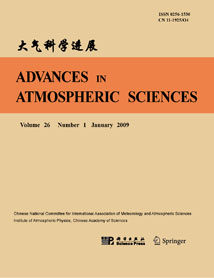| [1] |
CHEN Wen, WEI Ke,
2009: Interannual Variability of the Winter Stratospheric Polar Vortex in the Northern Hemisphere and their Relations to QBO and ENSO, ADVANCES IN ATMOSPHERIC SCIENCES, 26, 855-863.
doi: 10.1007/s00376-009-8168-6
|
| [2] |
Fei LI, Yvan J. ORSOLINI, Huijun WANG, Yongqi GAO, Shengping HE,
2018: Modulation of the Aleutian-Icelandic Low Seesaw and Its Surface Impacts by the Atlantic Multidecadal Oscillation, ADVANCES IN ATMOSPHERIC SCIENCES, 35, 95-105.
doi: 10.1007/s00376-017-7028-z
|
| [3] |
WEI Ke, BAO Qing,
2012: Projections of the East Asian Winter Monsoon under the IPCC AR5 Scenarios Using a Coupled Model: IAP-FGOALS, ADVANCES IN ATMOSPHERIC SCIENCES, 29, 1200-1214.
doi: 10.1007/s00376-012-1226-5
|
| [4] |
SHI Ning, and BUEH Cholaw,
2013: Three-dimensional dynamic features of two Arctic oscillation types, ADVANCES IN ATMOSPHERIC SCIENCES, 30, 1039-1052.
doi: 10.1007/s00376-012-2077-9
|
| [5] |
Xiangdong ZHANG, Yunfei FU, Zhe HAN, James E. OVERLAND, Annette RINKE, Han TANG, Timo VIHMA, Muyin WANG,
2022: Extreme Cold Events from East Asia to North America in Winter 2020/21: Comparisons, Causes, and Future Implications, ADVANCES IN ATMOSPHERIC SCIENCES, 39, 553-565.
doi: 10.1007/s00376-021-1229-1
|
| [6] |
Yan XIA, Yongyun HU, Jiankai ZHANG, Fei XIE, Wenshou TIAN,
2021: Record Arctic Ozone Loss in Spring 2020 is Likely Caused by North Pacific Warm Sea Surface Temperature Anomalies, ADVANCES IN ATMOSPHERIC SCIENCES, 38, 1723-1736.
doi: 10.1007/s00376-021-0359-9
|
| [7] |
Yong. L. McHall,
1991: Planetary Stationary Waves in the Atmosphere Part I: Orographic Stationary Waves, ADVANCES IN ATMOSPHERIC SCIENCES, 8, 211-224.
doi: 10.1007/BF02658095
|
| [8] |
Yong. L. McHall,
1991: Planetary Stationary Waves in the Atmosphere Part II: Thermal Stationary Waves, ADVANCES IN ATMOSPHERIC SCIENCES, 8, 225-236.
doi: 10.1007/BF02658096
|
| [9] |
Huang Ronghui,
1984: THE CHARACTERISTICS OF THE FORCED STATIONARY PLANETARY WAVE PROPAGATIONS IN SUMMER NORTHERN HEMISPHERE, ADVANCES IN ATMOSPHERIC SCIENCES, 1, 84-104.
doi: 10.1007/BF03187619
|
| [10] |
Lu Peisheng,
1992: The Structure and Propagation of Stationary Planetary Wave Packet in the Barotropic Atmosphere, ADVANCES IN ATMOSPHERIC SCIENCES, 9, 157-166.
doi: 10.1007/BF02657506
|
| [11] |
DENG Shumei, CHEN Yuejuan, HUANG Yong, LUO Tao, BI Yun,
2011: Transient Characteristics of Residual Meridional Circulation during Stratospheric Sudden Warming, ADVANCES IN ATMOSPHERIC SCIENCES, 28, 551-563.
doi: 10.1007/s00376-010-0010-7
|
| [12] |
LI Lin, LI Chongyin, PAN Jing, TAN Yanke,
2012: On the Differences and Climate Impacts of Early and Late Stratospheric Polar Vortex Breakup, ADVANCES IN ATMOSPHERIC SCIENCES, 29, 1119-1128.
doi: 10.1007/s00376-012-1012-4
|
| [13] |
LI Shuanglin, CHEN Xiaoting,
2014: Quantifying the Response Strength of the Southern Stratospheric Polar Vortex to Indian Ocean Warming in Austral Summer, ADVANCES IN ATMOSPHERIC SCIENCES, 31, 492-503.
doi: 10.1007/s00376-013-2322-x
|
| [14] |
Tao WANG, Qiang FU, Wenshou TIAN, Hongwen LIU, Yifeng PENG, Fei XIE, Hongying TIAN, Jiali LUO,
2023: The Influence of Meridional Variation in North Pacific Sea Surface Temperature Anomalies on the Arctic Stratospheric Polar Vortex, ADVANCES IN ATMOSPHERIC SCIENCES, 40, 2262-2278.
doi: 10.1007/s00376-022-2033-2
|
| [15] |
LIU Yi, LIU Chuanxi, Xuexi TIE, GAO Shouting,
2011: Middle Stratospheric Polar Vortex Ozone Budget during the Warming Arctic Winter, 2002--2003, ADVANCES IN ATMOSPHERIC SCIENCES, 28, 985-996.
doi: 10.1007/s00376-010-0045-9
|
| [16] |
Zixu WANG, Shirui YAN, Jinggao HU, Jiechun DENG, Rongcai REN, Jian RAO,
2024: Representation of the Stratospheric Circulation in CRA-40 Reanalysis: The Arctic Polar Vortex and the Quasi-Biennial Oscillation, ADVANCES IN ATMOSPHERIC SCIENCES, 41, 894-914.
doi: 10.1007/s00376-023-3127-1
|
| [17] |
Chen Wen, Huang Ronghui,
2002: The Propagation and Transport Effect of Planetary Waves in the Northern Hemisphere Winter, ADVANCES IN ATMOSPHERIC SCIENCES, 19, 1113-1126.
doi: 10.1007/s00376-002-0069-x
|
| [18] |
Zhu Zhengxin,
1985: EQUILIBRIUM STATES OF PLANETARY WAVES FORCED BY TOPOGRAPHY AND PERTURBATION HEATING AND BLOCKING SITUATION, ADVANCES IN ATMOSPHERIC SCIENCES, 2, 359-367.
doi: 10.1007/BF02677252
|
| [19] |
Tianju WANG, Zhong ZHONG, Ju WANG,
2018: Vortex Rossby Waves in Asymmetric Basic Flow of Typhoons, ADVANCES IN ATMOSPHERIC SCIENCES, 35, 531-539.
doi: 10.1007/s00376-017-7126-y
|
| [20] |
CHEN Gong, and LI Guoping,
2014: Dynamic and Numerical Study of Waves in the Tibetan Plateau Vortex, ADVANCES IN ATMOSPHERIC SCIENCES, 31, 131-138.
doi: 10.1007/s00376-013-1035-5
|















 AAS Website
AAS Website 
 AAS WeChat
AAS WeChat 
 DownLoad:
DownLoad: